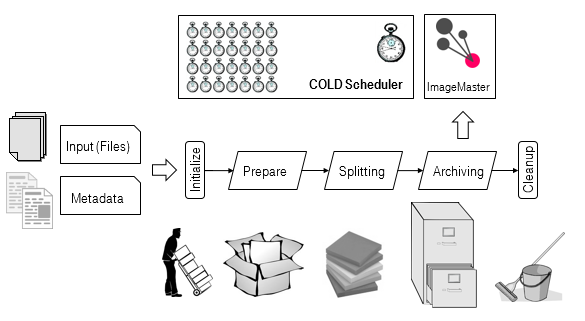Overview

Figure 302: Batch Processing – high level
Example scenario
Digitized documents from a scan provider together with their belonging metadata are supplied in a predefined file system location. In addition, also a backlog of digitized documents from an old system that is to be decommissioned can be provided alongside.
Batch Processing prepares the incoming data and documents, so they can be imported in ImageMaster via a standard interface, which is FIS for ImageMaster 9. All actions are logged. On successful termination of Batch Processing, the archived documents with their data can be retrieved via the ImageMaster 9 WorkplaceClient. In fact, any ImageMaster 9 mechanisms can be applied to manage the life cycle of these imported documents. For example, based on some kind of expiration date, which is reflected in the metadata, via Batch Processing during the import a retention plan can already be set, which protects the document from deletion.
Standard Process Stages
ImageMaster Batch Processing is a modular system consisting of components which can be combined according to individual project requirements. Process automation is based on scripts. Documents with belonging metadata are transferred via predefined directories in a file system. A typical standard step chain covers the following stages:
-
Initialize: receive the input packages (documents + metadata) and check if new input is available
-
Prepare: transform the incoming metadata into an internal standard format, e.g. based on CSV
-
Splitting: create batches of input packages suited for ImageMaster import (e.g. via FIS)
-
Archiving: import the packages to make them available as ImageMaster 9 document revisions
-
Cleanup: remove obsolete input files and intermediately generated files from the working directories
The Scheduler controls the process flow of a step chain. Each step chain is associated with a spool type name and each run of a step chain is instantiated with a unique generation number. One single step is reflected by a script. The outcome of a script execution signals to the Scheduler, how to proceed in the step chain, and several things can happen:
-
The same script has to be run again.
-
A particular follow-up script has to be run based on some condition.
-
An error is signaled: the processing of this generation is stopped and requires manual intervention.

Figure 303: Standard Batch Processing stages
ImageMaster Batch Processing is based on the following components:
-
Scheduler and Monitor (see chapter Batch Processing Scheduler and Monitor)
-
Processing based on scripts (see chapter Batch Processing control)
-
ImageMaster 9 File Interoperability Service (FIS) for bulk import and export [SM FIS]
The Scheduler manages the overall processes with their chronological executions and it triggers single batch processes. In the preparation stage the supplied data is parsed and transformed into a format with a structure that is suited for import into ImageMaster. The batch processes are always customized to satisfy individual project requirements.
There are dependencies between the Batch Processing design and the ImageMaster system. The ImageMaster Integration Service provides [SM IS] the core functionality for managing documents in an ImageMaster 9 archiving environment based on web services. Data structures can be set up to create, update, delete, and to store documents with their metadata in an electronic archive that is suited for long-term preservation. These archived objects can then be retrieved via the ImageMaster WorkplaceClient or via the Integration Service itself serving as an integration interface to other systems. An overview of ImageMaster 9 is presented in the product description [T Product Description].
Batch Processing export/import generally involves FIS and can be used in combination with the ImageMaster Service for ERP [SM ERP] and its related modules such as the ImageMaster SAP-Messenger [SM ERP MSG] and the MetadataSync for ERP [SM ERP MDS].
FIS is the file system interface used for bulk import and export in ImageMaster 9. This module has to be installed according to the system manual [SM FIS], with access to the ImageMaster Integration service. The ImageMaster Integration service is available in any standard ImageMaster 9 installation [IM ImageMaster].